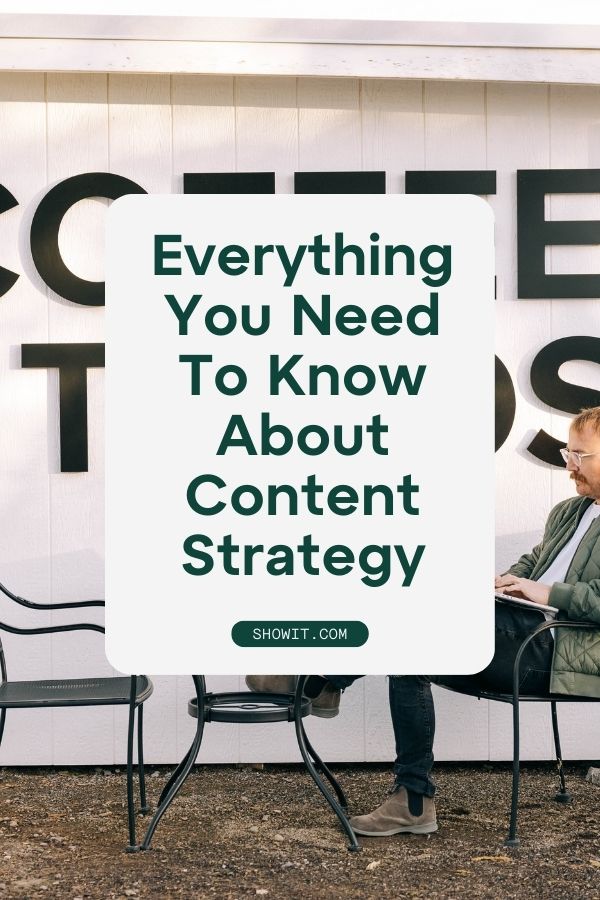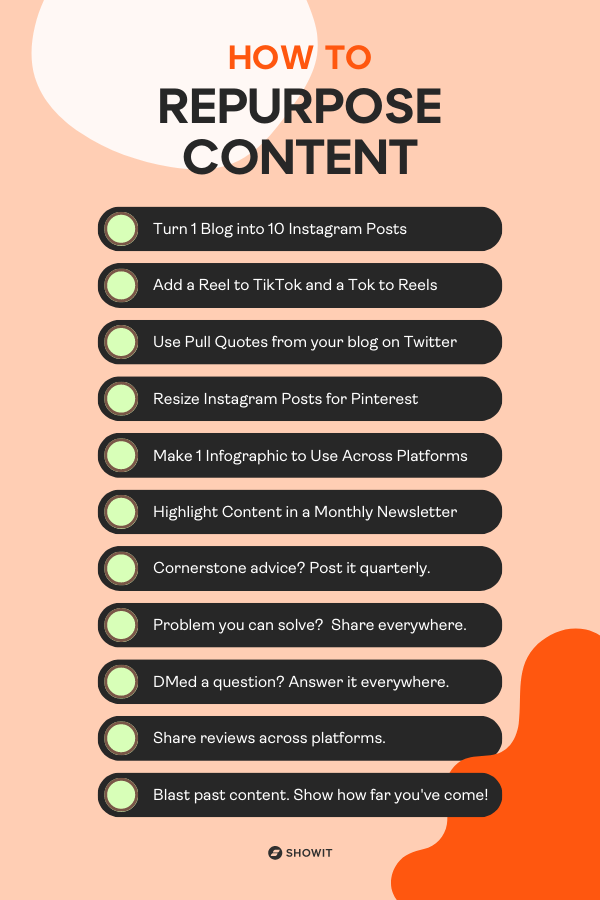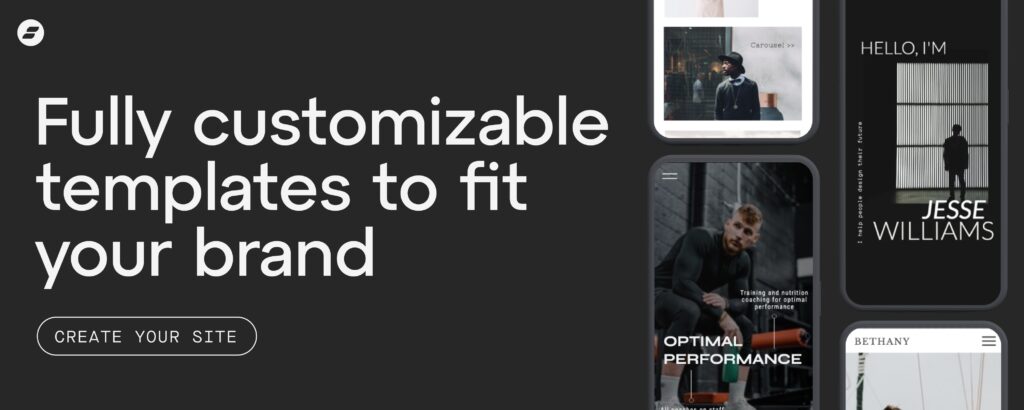We’ve made it, friend! This is officially the last post in our 10-part series all about the health of your website. You now know how to create the best possible website for your brand! And how to take that interest from your website and translate it into something lasting.
And for our final post, that idea of lasting is exactly what we want to chat with you about. Because while this may be the end of the series, the topic of this post is actually the beginning of building an online presence that will withstand the test of time. Finally, you have the knowledge to build a solid content strategy!

By now, you know how important having an awesome website is. And you learned how to keep your readers’ interest long after they’ve X-ed out.
But what we haven’t talked about yet is what to do with that interest. Once you’ve figured out a way to get your readers to take the leap from website visitor to regular client! That's where a plan comes in.
Here's where your content strategy—and content repurposing—comes in.
Content strategy is the process of planning, creating, and managing content to meet the needs of your target audience while also achieving your business goals. It’s a crucial part of any brand’s successful marketing strategy.
A well-defined content strategy helps you to create and distribute valuable, relevant content that attracts and retains a clearly defined audience.
The content strategy process ensures that every piece of content you create serves a specific purpose. Whether it is to educate, entertain, or persuade your target audience into taking your desired action, you have near-endless possibilites.

4 Benefits of a Solid Content Strategy
👉 It helps you understand your audience better.
By identifying their needs, preferences, and pain points, you can create content that is tailored to them. This then helps you build trust and credibility with your audience, which can lead to increased engagement and conversions.
The more specific your content is to your ideal clients’ questions, interests, and needs, the more they’ll trust you, engage with you, and ultimately buy from you.
👉 It helps you maintain a consistent brand voice.
By spending the time to create a consistent strategy, you’ll be able to maintain a consistent voice and tone that resonates with your target audience across all of your brand’s marketing.
Having a consistent voice in all of your content is so important for brand awareness and recognition because it’s one of the main things that sets you apart from your competitors.

People prefer to work with brands that feel human, and one of the best ways to help your audience make real connections with you is by making yourself recognizable and relatable with a brand voice they can count on.
👉 It keeps your content aligned with your business goals.
No matter what your goal is—increase brand awareness, generate leads, drive sales, gain subscribers, get new podcast listeners, encourage people to sign up for your course—all of your content should be designed to support your specific objectives.
When you have a strategy in place, content creation that actually gets you results is so much easier.
Instead of creating posts on the fly, writing blogs at random, and sending newsletters about any old topic, a solid content strategy built with your brand’s goals in mind supports your efforts by informing what you create—and removing the stress of the “what should I post?” guessing game.
Armed with a content strategy in your brand’s back pocket, you can ensure that your content is not only engaging and informative but also contributes to your bottom line.
👉 It provides you with a clear roadmap for your content creation efforts.
By identifying the types of content that are most effective in achieving your goals, you’re able to determine which types of content to prioritize, then create.
In this series, you have already outlined your objectives, defined your target audience, and got clever on your messaging. You probably already have even decided which content marketing channels you’ll use to share your content.
Now that you have all of those elements in place, the only thing left to do is create!
How to Create a Content Strategy That Actually Works
Creating a content strategy is nowhere near as difficult as it sounds. In fact, there are only a few steps you need to take in order to create an awesome content strategy that’ll work for you. You won't have to think about content creation for months! Woohoo!
Step #1 – Who is your content for? Why do they need it?
Content creation is an audience-first task. If you don’t know who you’re creating for—what they want from you, why they need it, what will make them care—you’re not setting yourself up for success.
Before making your content strategy, spend some time inside your community’s head; whether that means dreaming up your dream projects, chatting with some past clients who you loved working with, or researching details about your target audience online. You can revisit Part 2 of the series to refresh your brand strategy plan.

Step #2 – Get familiar with your goals
Think specifically, what are you marketing?
Is there a desired action you’re hoping your reader will take?
What is the solution you’re providing your audience?
Understanding WHY you’re posting, WHAT you want to promote, and WHO needs your message the most is vital in creating a solid content strategy.
Before sitting down to plan out your content, think about what you do, why you do it, who you do it for, and how you plan on spreading the word about the ways you’re able to solve your audience’s problems / meet their needs / provide value to them. Remember! You already did this in Part 2 with your Brand Strategy
Step #3 – Conduct your keyword research
It’s impossible to talk about content creation and not mention SEO, because half the reason you’re even creating content in the first place is likely so more of your people can find you organically.
For this reason, incorporating relevant keywords into your content—especially your long-form content—is essential, if you’re hoping to be more discoverable.
RELATED: Check out our article about conducting keyword research here!
Step #4 – Create content that moves the needle
Every piece of content you create should either trigger an action, inspire a next step, or move the needle forward for your reader—even if it’s only a little push in the right direction.
Our favorite way to do this is by thinking about what the call to action is (and who we’re hoping will take said action) before creating a certain element of content, so we can make sure we’re not getting off track or making something that doesn’t align with our goals or our audience’s needs.
Pssst. More on this in Part 5 of the series.

Step #5 – Think about what fuels your fire (and what fuels their fire)
It’s important to create content that feels authentic to you AND relevant to your audience. When making your content strategy, you’ll want to find a happy medium between the topics you’re passionate about, and the topics your audience can benefit from.
Step #6 – Decide what your posting schedule will be
It’s easy to get overwhelmed with content creation, especially with SO many platforms and types of content you can create, so deciding on a posting schedule will prove to be extremely helpful.
For example, when you know you need to post 3 times on Instagram, send one weekly newsletter, and publish twice a month on your blog, content creation becomes much more manageable than when you’re looking at an overflowing list of ideas that have no timeline attached.
Without a posting schedule, everything will feel urgent, and you’ll become frustrated with consistent content creation before you even get started.
A regular posting schedule also helps your audience become much more familiar with you, increasing engagement thanks to the reliability of your posting/sending/publishing/uploading.
If your numbers low? Check out: 5 Reasons You Have Low Engagement on Instagram
How to Figure Out Which Elements of Your Content Strategy to Prioritize Most
Even though you may try to be, you can’t be everywhere, all at once, all the time. It’s impossible to give your best on every platform—but that doesn’t mean it’s impossible to build a content strategy that allows you to take advantage of all of the marketing channels available to you.
The key to a successful (and sustainable!) content strategy is choosing 1-3 platforms that you feel like you can comfortably maintain putting effort into.
Then, if you determine you’d like to show up on other social media platforms or create other forms of marketing content, you can do so by repurposing the content you made for your “main” outlets.
HERE’S HOW TO CHOOSE WHICH PLATFORM IS GOING TO BE YOUR #1 FOCUS:
→ Determine which content is the easiest for you to create.
Love filming quick, short-form video content – focus on TikTok or Reels.
Enjoy writing long-form content – focus on your blog or newsletter.
Dream about creating graphics and writing captions – focus on Instagram.
You see where we’re going with this?
Doing what you genuinely LIKE doing is just as important as doing the strategic thing—because if you don’t actually enjoy it (or at least enjoy it more than the other social media and content marketing channels available to you), then it won’t be as easy for you to maintain.
Plus, followers, subscribers, readers, & viewers can ALWAYS tell when content feels forced.
If you spend your time creating content that you don’t like, just for the sake of being on a platform because you think you have to be there, your community won’t respond as well to it.
(Engaging with your community is the whole *point* of creating content in the first place!)
Pick a format of content you like, and run with it.

→ Determine what makes sense for your goals. Which action do you want your community to take?
When considering which platform to focus on, you’ll first need to decide what your goals are, and which platform makes the most sense for you to reach them.
Example No. 1: Photographers and videographers may want to prioritize photo- and video-based apps, like Instagram, Pinterest, and TikTok, so their ideal clients can see their work and get a feel for their style.
Example No. 2: Online service providers, like copywriters or virtual assistants, may want to prioritize content marketing channels that let them provide educational value and create long-form content to help their audience, like their blog or their email list.
Think about WHY you’re creating this content in the first place—which action you’re hoping your community will take—and then decide which content marketing tool would be best suited for that.
→ Determine which type of person is active on that specific platform. Is your ideal client likely to see your content there?
Once you know WHY you’re posting and WHAT you want to post to help you further your goals, you’ll need to make sure that your ideal client is actually hanging out in that corner of the Internet.
If you’ve decided that you’re going to start putting all of your energy into Facebook, but your audience is full of trendy Gen Z-ers, you’re probably not going to be able to attract the clientele you’re hoping for—because they’re not hanging out on Facebook.
You’ll need to find a balance between what you want to create, and what your audience likes to consume.
While we’re on the subject…
→ Determine how your ideal client likes to consume content. Are you creating what they want from you?
The last step in deciding which content marketing tool to prioritize is figuring out which type of content best resonates with your audience.
Do they appreciate funny, relevant gifs (like ours does)?
Are Instagram carousels their fav with all the info, over Instagram posts with a long caption?
Is your dream client actually reading the blogs linked to the Pinterest posts they’re saving? Or do they just like looking at the aesthetically pleasing photos?
Are they more likely to click on a link in your stories? Or does the “link in bio!” call to action from your feed post really work?
These are all things you’ll likely have to trial-and-error your way through. But chances are, if you know your audience well enough, it’ll be easy for you to get a good idea of the way they like to consume their content.
It’s also a great idea to simply ASK them. Conduct a poll on your stories. Send out a survey to your email list. Prompt readers to DM you on social media after they read your blog. Just ask. You get answers, engage your audience, and play to the algorithm.
The best way to find out what your audience REALLY wants is to have the conversation.
How to create a content ecosystem by repurposing what you create
Repurposing content is THE best way to create a cohesive, consistent content marketing strategy—and also the easiest.
(Plus, who doesn’t love *NOT* having to reinvent the wheel?!)

People love to over-complicate content creation for absolutely no reason. We promise you: content marketing doesn’t have to be that difficult.
As a business owner, you’ve got enough on your plate already, between client work, responding to leads, showing up on social media, handling your admin tasks, outsourcing to contractors, reviewing projects, editing things, existing as a human… it’s a lot!
And if there’s one place you can afford to simplify your life, it’s content creation.
Here’s how to make it happen:
Repurpose Your Content…a lot.
You won't believe how many times one piece of long-form content can be transformed! Just think of the possibilities when you consider all the ways to break down a given topic.
Content repurposing is the process of recycling or reusing your existing content in a new format. This way you maximize the ROI of your content creation. Not to mention, give every element of your content as much life as possible.)
We’ll keep our argument for content repurposing brief because we’re really excited to skip to the how-to of it all:
- It makes consistency easier. Organically marketing your business takes up enough time as it is; repurposing diminished your workload significantly.
- It saves you valuable time. The less fresh content you have to create from scratch, the less time you spend creating.
- It improves your SEO. The more content you have about a given topic (or keyword), the higher your chances of ranking on Google.

Content repurposing is a complete game-changer when it comes to growing your audience, posting regularly, and serving your social channels.
Don't Believe it? Check it out!
Let’s take this blog series, for example:
If we wanted to repurpose the content we shared with you over the course of these last 10 blogs, here are a few ways we could do it:
- Post 10 Instagram carousels
- Post 10 Instagram Reels
- Make 10 TikToks
- Make 10 YouTube videos
- Create 1-5 Instagram stories per post
- Write 10 newsletters
- Publish 10 idea pins
- Publish 1-5 regular Pinterest pins about each post, using alternate titles
- Publish infographics with the tips from each post on Pinterest
…and those are just a few ideas.
That’s HUNDREDS of elements of content—and we didn’t even mention the fact that every single post in this series could be broken down even further, making for even more content.
With every element of each blog in this series, there’s also a new opportunity for a fresh, new piece of content to be created.
Remember Part #5, all about how to write the best website copy? Here are all the individual topics we could post about from that specific content of that specific:
- Informational post: what is website copy and why do you need it?
- Informational post: how to write website copy that works
- Informational post: what great website copy can do for you (4 benefits of having great website copy)
- Informational post: 6 questions to ask yourself before writing your own website copy
- Educational post: what your homepage needs to include
- Repeat for About, Services, and Contact!
- Educational post: how to add personality to your homepage copy
- Repeat for About, Services, and Contact!
- Freebie: website copywriting checklist
That’s THIRTEEN additional elements of content from ONE blog post—not counting all the different types of posts that could be made about each element from the above list, or the potential pull quotes we could post from the article.
(This is the part where we remind you exactly how beneficial blogging is to your small business.)
Repurpose. Then Do It Again.
And the repurposing doesn’t end there—check out just how many additional elements of content you can turn ONE long-form piece into. 👇

Don't forget you don't have to reinvent the wheel. You probably already have a ton of content you can use. Bet you have enough to repurpose content into…
- Turn 1 Blog into 10 Instagram Posts.
- Add a Reel to TikTok and a Tok to Reels.
- Use Pull Quotes from your blog on Twitter
- Resize Instagram Posts for Pinterest
- Make 1 Infographic to Use Across Platforms.
- Highlight Content in a Monthly Newsletter.
- Cornerstone advice? Post it quarterly.
- Problem you can solve? Share everywhere.
- DMed a question? Answer it everywhere.
- Share reviews across platforms.
- Blast past content. Show how far you've come!
And, friend, you have come so far. Just think of all the amazing things you have learn across your years in business. Heck, you have learned so much just in this post about content strategy! Not to mention the whole Website Health Check-up Series!
We hope you loved reading this series as much as we loved writing it—don’t forget to SAVE it for later!
We’ve had so much fun teaching you about your website health, website mistakes to avoid, brand strategy, SEO, website copywriting, website design, user experience, blogging, building relationships with your readers, and now content strategy, and we hope you’ve had just as much fun learning about it all!
Don’t forget to save this series somewhere safe (we suggest Pinterest!) so you can refer back to it.
And if you don’t have a website yet—or if you’re looking for a website builder that gives you the most creative freedom to create an online presence that feels like you do in person—start here for FREE for 14 days (no credit card, just vibes).

